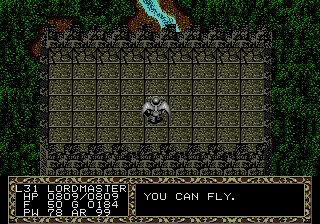I played: Fatal Labyrinth
Fatal Labyrinth is a game for the Sega Genesis / Mega Drive, available emulated in several collections. It takes a couple hours to finish, but you will probably need to play it multiple times (or save scum) to do so.

As someone who played Nintendo consoles as a kid, my exposure to Sega is pretty much 1) Sonic, and 2) the trainwreck they are now. So Sonic's Ultimate Genesis Collection - the headlining title being the least interesting - is pretty much designed for me. One thing I was stunned to find on it was Fatal Labyrinth which as far as I can tell was the first console roguelike. In fact, released in 1990, it's contemporary with Angband (and so not too surprisingly, it's much more Hack-like than future Japanese roguelikes - persistent levels and only a cursory town).
Honestly? The game is crap, even if you can fly. But as is usual for roguelikes most comments complain about the reviewer's dislike of fundamental aspects of the genre, rather than the particular implementation. That is if you handed them Shiren, Pokemon Mystery Dungeon, and ADOM, they'd review them all the same.
What Worked
The level generation, including secret doors, was fine. I think it was a little more interesting than the random generation present in later Chunsoft-developed roguelikes. Rogue is meticulously balanced in terms of food vs. exploration and Chunsoft games tended to ignore that by eschewing secret doors. While there's an abundance of food in Fatal Labyrinth you can't actually pick it up and need to eat it on the spot, so starvation is a real threat in the early levels if you explore inefficiently.
The "you've been on the level too long" notification, common in Japanese roguelikes, is found here. Probably for the first time. Between this and the food, the game does a good job of forcing you into progressively harder levels at the right pace.
There were breeders, enemies that spawn copies of themselves.
The theoretical difficulty curve was good, but I'll get to some particulars of why it was bad at the end.
What Didn't Work
The controls. I don't think I was happy with a set of roguelike controls on a dedicated gaming device until Izuna Ni. Notably, you can't turn without moving.
The UI. There's some excuse here for the same reason as the controls (I won't blame it for attack numbers getting truncated to two digits) but in other cases it's horrible. You can't see what an item is until you pick it up, you can't see how satiating food is until you eat it, and if you cancel out of the second or third stage of the three-level menu you need to start over from the first.
Loot is shallow. There's a lot of things (and the full gamut of types - armor, scrolls, wands, rings, and a couple classes of weapons) including some cursed items, but they don't have +X/-X variants variants.
The key place the game falls over is risk management. The primary goal of the player in a roguelike is to minimize the effect of the random number generator, because unpredictability is always what makes you lose. This problem manifested in two ways. First, damage variance was enormous. Tracking damage per hit looked like 12, 5, 106, 45, 19, 2, 95. Especially when you first encountered enemies I had no idea how much damage they could do, even after they hit me half a dozen times. Even if I knew I was safe I had no idea how long it would take me to kill the enemy.
Second, I had no options to mitigate non-damage risks. It's common for there to be rings or scrolls that will prevent some class of status ailment or raise your resistance to it but this game had no such thing I could find. I probably spent 90% of levels 15 to 25 confused, and all the items to fix that are consumable. None of the rings or armor offered me resistance benefits I could see, and the enemy attacks could be done at range so using a bow or shuriken did not help.
Fatal Labyrinth is a game I'm unlikely to ever play again, but as first efforts go it's an admirable re-imagining of Rogue for a console system.